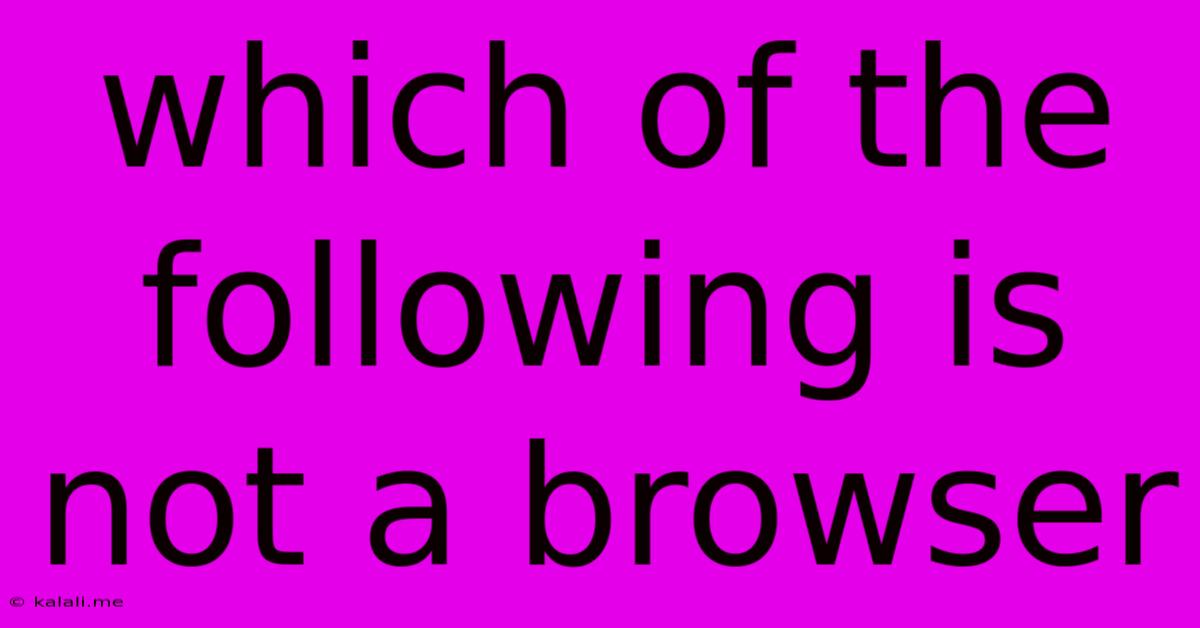Which Of The Following Is Not A Browser
Kalali
Jun 13, 2025 · 3 min read

Table of Contents
Which of the Following is Not a Browser? Identifying Web Browser Software
This article will clarify what constitutes a web browser and help you distinguish it from other types of software. Understanding the core functions of a browser is crucial in today's digital landscape, where web browsing is a primary activity for most internet users. We'll explore the key features of popular browsers and show you how to identify what isn't one.
What is a Web Browser?
A web browser is a software application that allows users to access and interact with information on the World Wide Web. It interprets website code (HTML, CSS, JavaScript) and renders it visually on your screen. Essentially, it's the gateway to the internet. Key features of a web browser include:
- Rendering web pages: Displaying websites correctly, including text, images, and videos.
- Handling URLs: Processing web addresses to retrieve information from servers.
- Managing HTTP requests: Communicating with web servers to download website content.
- Supporting various protocols: Working with different web protocols like HTTP, HTTPS, FTP.
- Providing user interface elements: Offering features such as address bars, back/forward buttons, and bookmarks.
- Security features: Protecting users from malicious websites and online threats.
Examples of Popular Web Browsers:
You're likely familiar with several popular web browsers already:
- Google Chrome: Known for its speed and extensive extensions.
- Mozilla Firefox: A customizable and privacy-focused browser.
- Safari: Apple's default browser, optimized for Apple devices.
- Microsoft Edge: Microsoft's modern browser, replacing Internet Explorer.
- Opera: A browser with a built-in VPN and ad blocker.
Identifying Non-Browser Software:
Now, let's look at software that is not a web browser. Many applications interact with the internet, but they don't fulfill the core functions of a web browser described above. These include:
- Email Clients (e.g., Outlook, Thunderbird): These applications are primarily designed for managing emails, not for browsing websites. While they might use web technologies internally, they don't act as a primary interface for web browsing.
- File Transfer Protocols (FTP) Clients (e.g., FileZilla): FTP clients facilitate file transfers between a computer and a server. They don't interpret or display web pages.
- Search Engines (e.g., Google, Bing, DuckDuckGo): Search engines are tools for finding information online. They provide results, but you still need a browser to actually view the websites listed in those results.
- Operating Systems (e.g., Windows, macOS, Linux): These are the foundational software for your computer, managing its resources. They might include a browser, but the operating system itself is not a browser.
- Web Servers (e.g., Apache, Nginx): Web servers are the software that hosts websites. They provide the content, but they are not used to view the content.
In Conclusion:
Distinguishing a web browser from other software boils down to its core function: providing a user interface for viewing and interacting with content on the World Wide Web. If a program doesn't directly interpret and render web pages, manage HTTP requests, and handle URLs, then it is not classified as a web browser. Understanding this distinction is vital for navigating the digital world effectively.
Latest Posts
Latest Posts
-
What Is The Prime Factorization Of 225
Jun 14, 2025
-
Write 80 As A Product Of Prime Factors
Jun 14, 2025
-
Magnetic Field Lines Inside A Bar Magnet
Jun 14, 2025
-
Which Of The Following Is True Of Classical Conditioning
Jun 14, 2025
-
Which Of The Following Is In The Correct Order
Jun 14, 2025
Related Post
Thank you for visiting our website which covers about Which Of The Following Is Not A Browser . We hope the information provided has been useful to you. Feel free to contact us if you have any questions or need further assistance. See you next time and don't miss to bookmark.